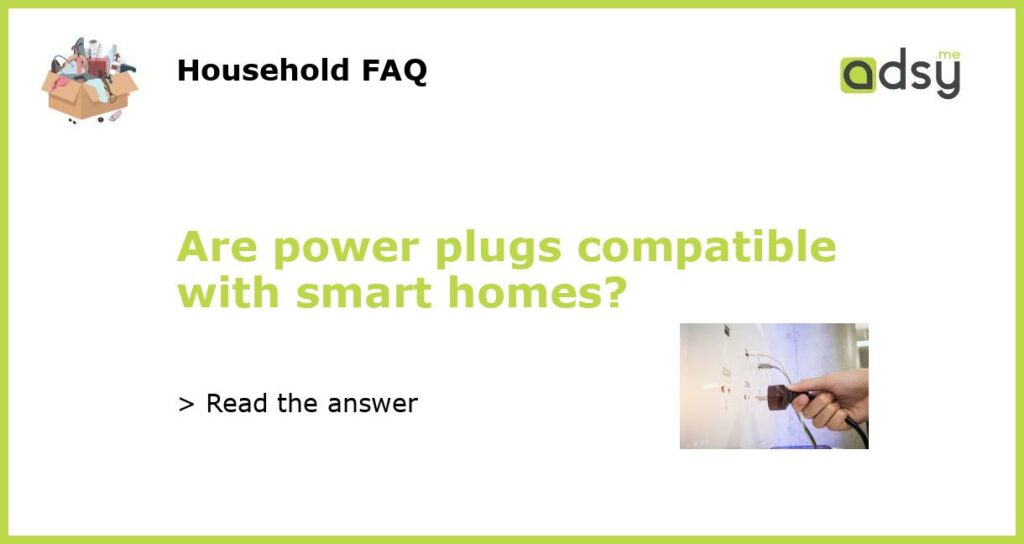Power Plugs and Smart Homes: Are They Compatible?
In today’s technology-driven world, the concept of a smart home has become increasingly popular. A smart home is a residence equipped with various devices that can be controlled remotely, automating and enhancing the functionality and efficiency of the home. These devices include lighting systems, thermostats, security cameras, and even kitchen appliances. However, one question that often arises when considering the implementation of a smart home is whether power plugs are compatible with such systems.
Understanding Power Plugs
Power plugs, also known as electrical outlets, are used to connect electrical devices to a power supply. They come in different shapes and sizes, depending on the country or region, with each having its own standard. For example, in North America, the most common type of power plug is the NEMA 5-15, which has two flat parallel pins and a grounding pin. In contrast, the standard power plug in Europe is the Schuko, which has two round pins and a grounding clip.
One of the main concerns regarding power plugs and smart homes is whether the installation of smart devices requires special electrical outlets or if these devices can be plugged into existing outlets. This concern stems from the fact that some smart devices, such as smart plugs and power strips, may require additional features or compatibility with specific protocols in order to function properly.
Compatibility of Smart Plugs
Smart plugs are one of the most commonly used devices in smart homes. They allow users to control the power supply of connected devices remotely, using a smartphone or voice commands. In most cases, smart plugs are designed to fit into existing power outlets and do not require any special electrical configurations.
However, it is important to note that not all smart plugs are compatible with every type of power outlet. For example, a smart plug designed for North American outlets may not fit or work properly in a European power socket. Therefore, when purchasing smart plugs, it is essential to check their compatibility with the power outlets in your country or region.
Compatibility of Power Strips
Power strips, also known as surge protectors or extension cords, are another commonly used device in households. They allow multiple devices to be plugged into a single outlet, providing additional electrical sockets. Some power strips are also equipped with smart features, such as USB ports and remote control capabilities.
Similar to smart plugs, the compatibility of smart power strips with existing power outlets depends on the specific region or country. Power strips designed for North American outlets may not be compatible with European or Asian power sockets. Therefore, it is necessary to consider the compatibility of power strips when integrating them into a smart home setup.
Adapters and Compatibility Solutions
In cases where existing power outlets are not compatible with smart plugs or power strips, adapters or compatibility solutions can be used. Adapters are devices that convert one type of power plug into another, allowing devices with different plug standards to be used with local power outlets.
There are several types of adapters available in the market, such as universal travel adapters, which are specifically designed for travelers. These adapters typically support multiple plug configurations and can be used in various countries. However, it is important to ensure that the voltage requirements of the device are compatible with the local power supply.
The Future of Power Plugs in Smart Homes
As technology continues to advance, so does the compatibility of power plugs with smart home systems. Many manufacturers are now developing products that are compatible with a wide range of power outlets, ensuring that smart devices can be easily integrated into any home, regardless of the region or country.
Moreover, some smart devices are becoming wireless, eliminating the need for physical power connections altogether. For example, wireless charging pads are becoming increasingly popular, allowing devices to be charged by simply placing them on the pad, without the need for cables or power plugs.
In conclusion, power plugs can be compatible with smart homes, but it is essential to consider the specific requirements and compatibility of the devices being used. Smart plugs and power strips may require specific configurations or adapters to work with existing power outlets. However, as technology progresses, the compatibility between power plugs and smart homes is expected to improve, making it easier for homeowners to create a smart and efficient living environment.






